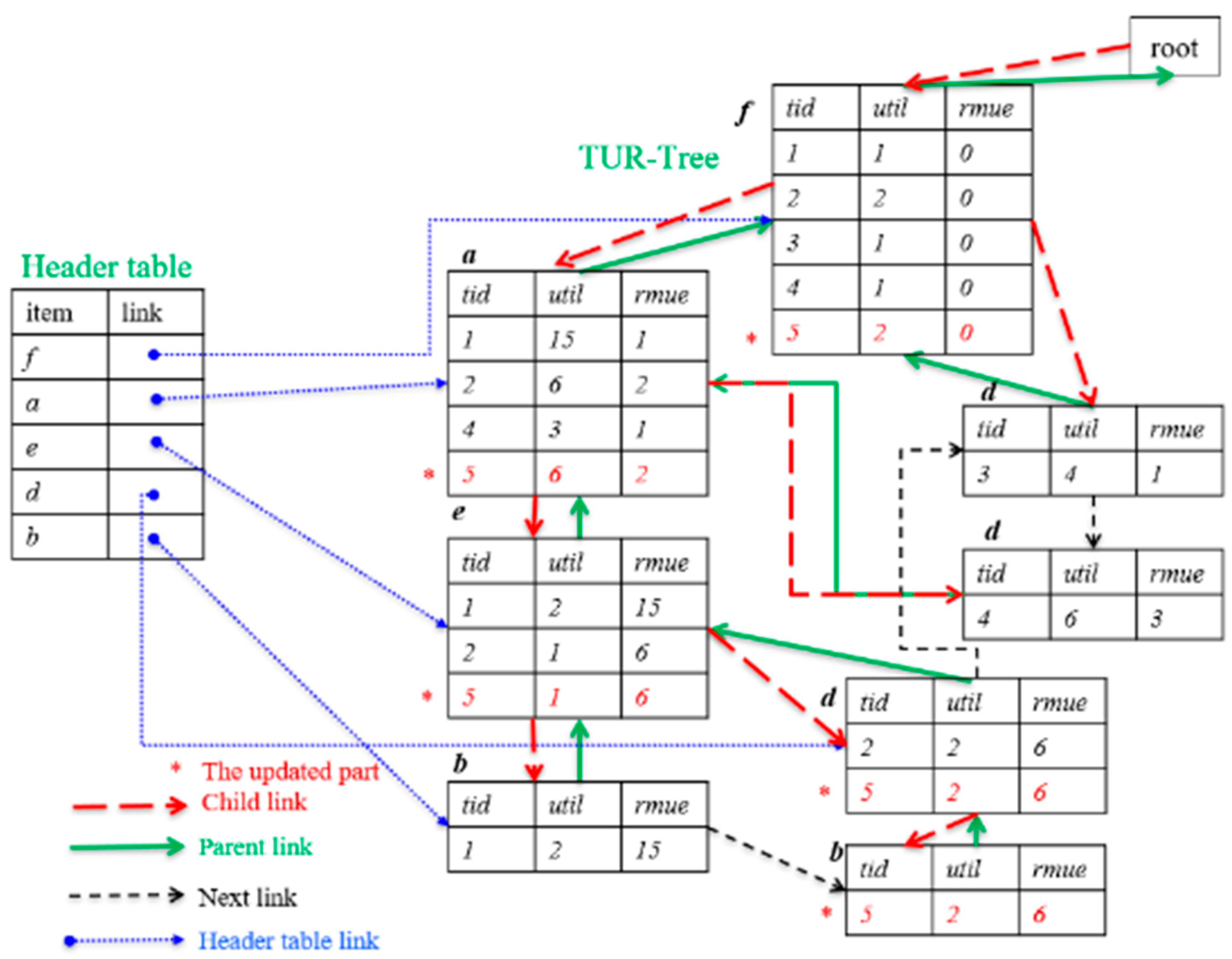An Efficient Approach for Mining High Average-Utility Itemsets in Incremental Database †
Abstract
1. Introduction
2. Algorithms for High Average Utility Itemsets (HAUIs) with Multiple Maximum Transmission (MMUT) Units
2.1. TUB-HAUPM Algorithm
2.2. Generalized High Average-Utility Itemset Mining (GHAIM) Algorithm
3. Developed Algorithm
3.1. Basic Ideas
3.2. Data Structure
3.2.1. Item-Based Table
3.2.2. Transaction Set Table
3.3. Construction of TUR-Tree
- Child link: Connects a parent node to its child nodes;
- Parent link: Establishes the hierarchical structure;
- Next link: Helps locate the next occurrence of the same item for mining;
- Header table link: Serves as the starting point for the mining process.
3.4. Pruning Strategy
- AUUB pruning strategy [7]: Eliminates itemsets whose AUUB values fall below the SMAU value.
- Transaction set pruning strategy: Uses the transaction set table to quickly determine if an itemset is empty, avoiding unnecessary searches.
3.5. Mining Process for Static Database
3.6. Mining Process for Incremental Database
4. Performance Evaluation
4.1. Synthetic Datasets
4.2. Real Datasets
5. Conclusions
Author Contributions
Funding
Institutional Review Board Statement
Informed Consent Statement
Data Availability Statement
Conflicts of Interest
References
- Gao, M.J.; Lin, J.X.; Wu, J.W. An Efficient Algorithm for High Average Utility Itemset Mining with Buffered Average Utility-List. In Proceedings of the 7th International Conference on Information Science and Control Engineering (ICISCE), Changsha, China, 18 December 2020. [Google Scholar]
- Wu, J.M.-T.; Lin, J.C.-W.; Pirouz, M.; Fournier-Viger, P. Fournier-Viger, TUB-HAUPM: Tighter Upper Bound for Mining High Average-Utility Patterns. IEEE Access 2018, 6, 18655–18669. [Google Scholar] [CrossRef]
- Yun, U.; Nam, H.; Kim, J.; Kim, H.; Baek, Y.; Lee, J.; Yoon, E.; Truong, T.; Vo, B.; Pedrycz, W. Efficient Transaction Deleting Approach of Pre-Large Based High Utility Pattern Mining in Dynamic Databases. Future Gener. Comput. Syst. 2020, 103, 58–78. [Google Scholar] [CrossRef]
- Krishnamoorthy, S. Mining Top-k High Utility Itemsets with Effective Threshold Raising Strategies. Expert Syst. Appl. 2019, 117, 148–165. [Google Scholar] [CrossRef]
- Krishnamoorthy, S. Efficient Mining of High Utility Itemsets with Multiple Minimum Utility Thresholds. Eng. Appl. Artif. Intell. 2018, 69, 112–126. [Google Scholar] [CrossRef]
- Lin, J.C.-W.; Ren, S.; Fournier-Viger, P. MEMU: More Efficient Algorithm to Mine High Average-Utility Patterns with Multiple Minimum Average-Utility Thresholds. IEEE Access 2018, 6, 7593–7609. [Google Scholar] [CrossRef]
- Sethi, K.K.; Ramesh, D. High Average-Utility Itemset Mining with Multiple Minimum Utility Threshold: A Generalized Approach. Eng. Appl. Artif. Intell. 2020, 96, 103933–103948. [Google Scholar] [CrossRef]
- Sciore, E. Gennick. In Java Program Design; Springer: Berlin/Heidelberg, Germany, 2019. [Google Scholar]
- Fournier-Viger, P.; Lin, J.C.; Gomariz, A.; Gueniche, T.; Soltani, A.; Deng, Z.; Lam, H.T. The SPMF Open-Source Data Mining Library Version 2. In Proceedings of the 19th European Conference on Principles of Data Mining and Knowledge Discovery (PKDD 2016) Part III, Riva del Garda, Italy, 19–23 September 2016. [Google Scholar]






| TID | (Item, Quantity) |
|---|---|
| T1 | (a, 5) (b, 2) (e, 2) (f, 1) |
| T2 | (a, 2) (d, 1) (e, 1) (f, 2) |
| T3 | (c, 1) (d, 2) (f, 1) |
| T4 | (a, 1) (d, 3) (f, 1) |
| T5 | (a, 2) (b, 2) (d, 1) (e, 1) (f, 2) |
| Item | Profit |
|---|---|
| a | 3 |
| b | 1 |
| c | 2 |
| d | 2 |
| e | 1 |
| f | 1 |
| Item | MATV |
|---|---|
| a | 7 |
| b | 6 |
| c | 7 |
| d | 5 |
| e | 9 |
| f | 8 |
| Item | auub |
|---|---|
| a | 33 |
| b | 21 |
| c | 4 |
| d | 22 |
| e | 27 |
| f | 37 |
| TID\Item | a | b | c | d | e | f |
|---|---|---|---|---|---|---|
| T1 | 15 | 2 | 0 | 0 | 2 | 1 |
| T2 | 6 | 0 | 0 | 2 | 1 | 2 |
| T3 | 0 | 0 | 2 | 4 | 0 | 1 |
| T4 | 3 | 0 | 0 | 6 | 0 | 1 |
| T5 | 6 | 2 | 0 | 2 | 1 | 2 |
| Itemset\Transaction Set | The Transactions Where the Itemset Appears |
|---|---|
| a | T1, T2, T4, T5 |
| b | T1, T5 |
| c | T3 |
| d | T2, T3, T4, T5 |
| e | T1, T2, T5 |
| f | T1, T2, T3, T4, T5 |
Disclaimer/Publisher’s Note: The statements, opinions and data contained in all publications are solely those of the individual author(s) and contributor(s) and not of MDPI and/or the editor(s). MDPI and/or the editor(s) disclaim responsibility for any injury to people or property resulting from any ideas, methods, instructions or products referred to in the content. |
© 2025 by the authors. Licensee MDPI, Basel, Switzerland. This article is an open access article distributed under the terms and conditions of the Creative Commons Attribution (CC BY) license (https://creativecommons.org/licenses/by/4.0/).
Share and Cite
Chang, Y.-I.; Wu, C.-C.; Kuo, H.-E. An Efficient Approach for Mining High Average-Utility Itemsets in Incremental Database. Eng. Proc. 2025, 108, 32. https://doi.org/10.3390/engproc2025108032
Chang Y-I, Wu C-C, Kuo H-E. An Efficient Approach for Mining High Average-Utility Itemsets in Incremental Database. Engineering Proceedings. 2025; 108(1):32. https://doi.org/10.3390/engproc2025108032
Chicago/Turabian StyleChang, Ye-In, Chen-Chang Wu, and Hsiang-En Kuo. 2025. "An Efficient Approach for Mining High Average-Utility Itemsets in Incremental Database" Engineering Proceedings 108, no. 1: 32. https://doi.org/10.3390/engproc2025108032
APA StyleChang, Y.-I., Wu, C.-C., & Kuo, H.-E. (2025). An Efficient Approach for Mining High Average-Utility Itemsets in Incremental Database. Engineering Proceedings, 108(1), 32. https://doi.org/10.3390/engproc2025108032





